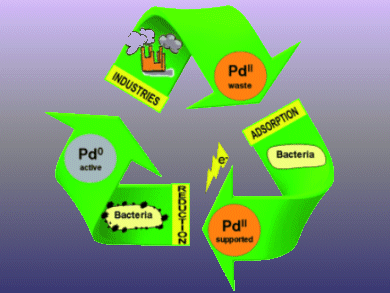Heavy metals discharged by mining, metallurgical, electronic, and electroplating industries are abundant water and soil contaminants. Biosorption uses readily available biomass to sequester toxic heavy metals, leading to bioregeneration of contaminated sites and recovery of valuable metals.
Troels Skrydstrup, Rikke Meyer, and co-workers, Aarhus University, Denmark, have demonstrated that pure, nonpalladized bacterial biomass can be used to recover Pd from undiluted waste. Two microbial strains with highly active hydrogenases were selected: Cupriavidus necator and Cupriavidus metallidurans. These bacteria absorbed Pd(II) onto their surfaces. Reduction to Pd(0) by formate formed nanoparticles which remained attached to the cell surface within the periplasmic space.
The biosupported Pd(0) formed in this process was used as a catalyst for C–C bond formation, illustrating the direct recovery of an active catalyst from industrial waste.
- Environmentally Benign Recovery and Reactivation of Palladium from Industrial Waste by Using Gram-Negative Bacteria
D. Gauthier, L. S. Søbjerg, K. M. Jensen, A. T. Lindhardt, M. Bunge, K. Finster, R. L. Meyer, T. Skrydstrup,
ChemSusChem 2010, 3, 1036–1039.
DOI: 10.1002/cssc.201000091




